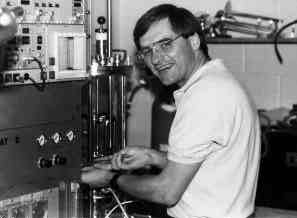David P. Nagle, Jr.
Associate Professor,
Physiology and Genetics of Anaerobes
Methane-producing Archaea are novel microorganisms whose metabolism differs greatly from more familiar Bacteria. Methanogens are important in anoxic biogeochemical cycles, converting one-carbon compounds and acetate to methane via pathways with unusual coenzymes.  Biochemical and genetic approaches to these organisms led us to areas that range from specific studies on a single enzyme in purine metabolism, to methods for genetic exchange, and to a potential inhibitor probe of the roles of methanogens in various ecosystems.
Biochemical and genetic approaches to these organisms led us to areas that range from specific studies on a single enzyme in purine metabolism, to methods for genetic exchange, and to a potential inhibitor probe of the roles of methanogens in various ecosystems.
Using toxic base analogs we isolated resistant mutants, and from metabolic and enzyme studies on these strains deduced pathways for purine and pyrimidine base salvage in Methanobacterium thermoautotrophicum. Nucleobase salvage reactions appear to be ubiquitous: they are well known in Bacteria and Eucaryotes and now seem to be similar in the Archaea. We have recently purified a bifunctional salvage enzyme from the methanogen for comparison to known enzymes. Hypoxanthine-guanine phosphoribosyltransferase retained 95% of its activity at 92 C. The analogous enzymes from bacteria and yeast were highly thermoactive, unexpected for organisms with moderate growth temperatures. Phylogenetic relationships among the structures of enzymes from archaea, bacteria, and eucaryotes may be revealing and are being pursued.
In a study of potential inhibitors of methanogens we found that the pterin lumazine (2,4-pteridinedione) inhibited methanogenesis specifically. Although LZ is an analog of the pteridines that carry out one-carbon transfer in methanogenesis, it was unexpected (unpublished) that LZ inhibited the reduction of Methyl Coenzyme M to methane -- a reaction unique to methanogene and not involving pterins. Lumazine may be used to inhibit this metabolic group selectively in ecological studies to help elucidate the role of methanogens in biodegradation schemes. With some difficulty we isolated a lumazine-resistant strain. Preliminary indications are that the mutant expends considerable energy to overcome inhibition; it is hoped to utilize this strain to delve into bioenergetics of methanogens.
Research projects related to those above include additional studies on the genetics of methanogens, a field which has suffered from technical barriers to the introduction of genes into cells. We found methods to transform M. thermoautotrophicum. We are involved in collaborative studies on the biosynthetic function of formate in methanogens and on methanogenesis driven by oxidation of elemental metals (biocorrosion), and are extending our work on purine and pyrimidine metabolism to other archaea, particularly the halobacteria.
We have begun another research front on bioremediation for the food service industry. Food grease comprises a serious problem for both infrastructure and waste disposal to the industry and municipalities. We are interested in processes which employ microorganisms to biodegrade food grease both on-site and off-site.
Selected Publications
- "A genetic transformation system in the archaebacterium Methanobacterium thermoautotrophicum." V. E. Worrell, D. P. Nagle, D. McCarthy, and A. Eisenbraun. J. Bacteriol. 170, 653-656 (1988).
- "Genetic and physiological characterization of the purine salvage pathway in the archaebacterium Methanobacterium thermoautotrophicum Marburg." V. E. Worrell and D. P. Nagle. J. Bacteriol. 172, 3328-3334 (1991).
- "Anaerobic oxidation of elemental metals coupled to methanogenesis by Methanobacterium thermoautotrophicum." W. H. Lorowitz, D. P Nagle, and R. S. Tanner. Environ. Sci. Technol. 26, 1606-1610 (1992).
- "The pterin lumazine inhibits growth of methanogens and methane formation." K. R. Nagar-Anthal, V. E. Worrell, R. Teal, and D. P. Nagle. Arch. Microbiol. September (1996)
- "Purification and properties of thermoactive hypoxanthine-guanine phosphoribosyltransferase from Methanobacterium thermoautotrophicum." M. M. Parekh and D. P. Nagle. in preparation (1996).
 Biochemical and genetic approaches to these organisms led us to areas that range from specific studies on a single enzyme in purine metabolism, to methods for genetic exchange, and to a potential inhibitor probe of the roles of methanogens in various ecosystems.
Biochemical and genetic approaches to these organisms led us to areas that range from specific studies on a single enzyme in purine metabolism, to methods for genetic exchange, and to a potential inhibitor probe of the roles of methanogens in various ecosystems.